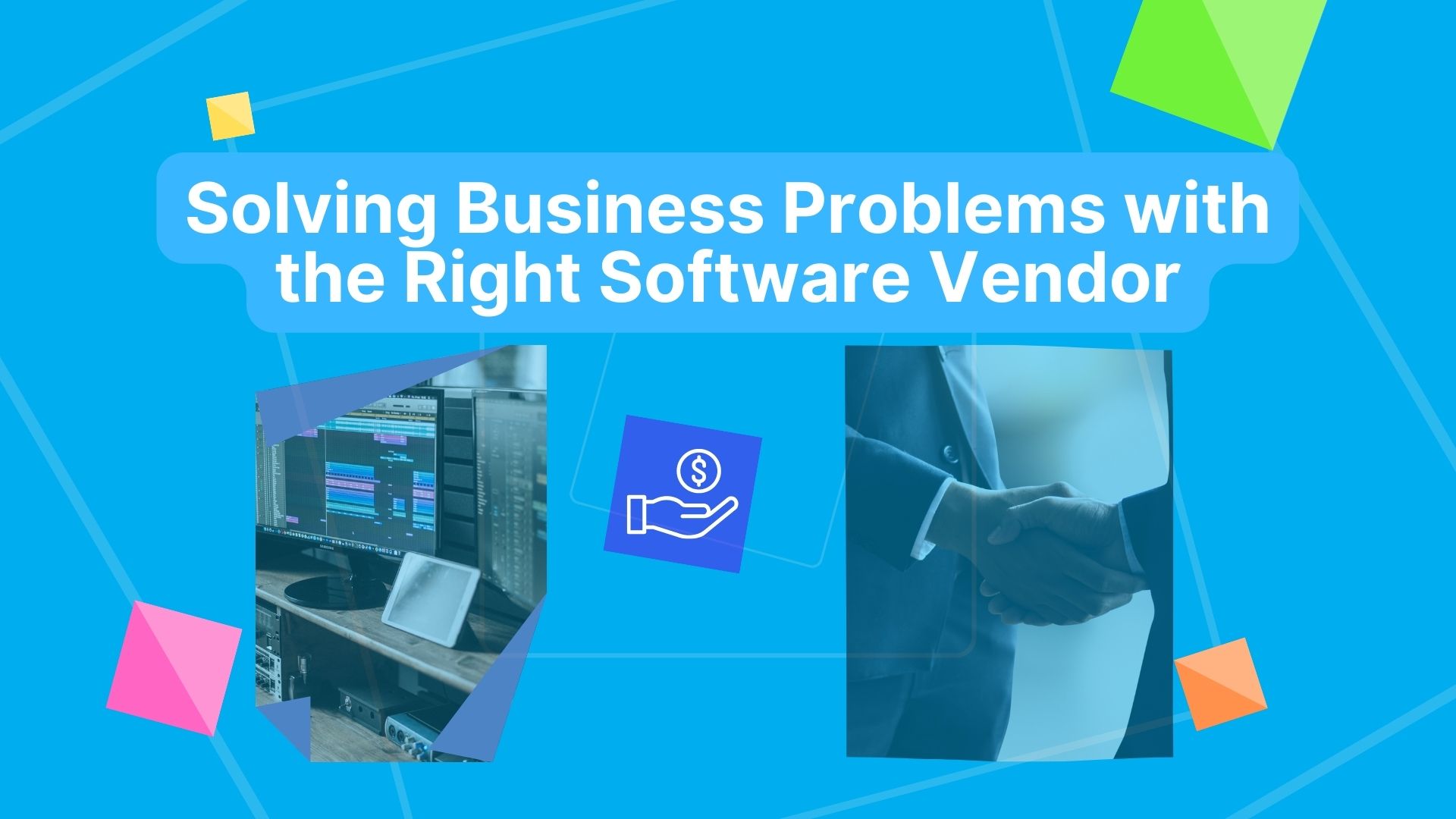Businesses of all sizes and industries rely on software solutions to improve efficiency, automate processes, and make data-driven decisions. However, with so many software vendors on the market, it can be difficult to know which one is the best fit for your business. Choosing the right software vendor is crucial, as the wrong choice can lead to wasted time and resources, as well as a solution that doesn’t meet the needs of your business.
Solving Business Problems with the Right Software Vendor
This guide will provide a step-by-step process for identifying the problem, researching potential vendors, evaluating the vendor, reviewing the solution, making a decision, and ensuring a successful implementation. By following these steps, businesses can make an informed decision on the software vendor that will best solve their specific problem and support their long-term growth.
Identify the Problem
The first step in solving a business problem with the right software vendor is to clearly identify the problem that needs to be addressed. This involves conducting a thorough analysis of the current processes, systems, and data within the organization to understand where the pain points are and how they are impacting the business.
Some key questions to consider when identifying the problem include:
- What specific tasks or processes are taking too long or causing delays?
- What data is currently being collected and how is it being used?
- Are there any areas where manual processes could be automated to improve efficiency?
- Are there any compliance or regulatory requirements that need to be met?
It is important to involve key stakeholders and subject matter experts in the problem identification process to ensure that all perspectives are taken into account. Additionally, it is a good practice to document the problem and its impact on the business so that it can be used as a reference during the vendor selection process.
By clearly identifying the problem, businesses can ensure that they are searching for software solutions that will address their specific needs and provide measurable benefits. Without a clear understanding of the problem, it can be difficult to evaluate whether a software solution is the right fit for the business.
Research Potential Vendors
Once the problem has been identified, the next step is to research potential vendors that offer software solutions that can address the problem.
There are several ways to research potential vendors, including:
- Online reviews: Look for online reviews from other businesses that have used the software. These reviews can provide valuable insight into the vendor’s customer support, implementation process, and overall satisfaction.
- Industry publications: Read articles and whitepapers from industry publications that discuss the software and the vendor. This can provide an overview of the vendor’s capabilities, as well as their reputation in the industry.
- Professional networks: Network with other professionals in the industry to find out which software solutions they have used and their experience with the vendor.
- Trade shows: Attend trade shows and conferences where software vendors showcase their products. This is an opportunity to see the software in action, ask questions and meet the vendor representatives.
- Demos: Request for demos from the shortlisted vendors to have a hands-on experience of the software, and see if it aligns with the business’s needs.
It is important to research multiple vendors and compare their capabilities to ensure that the best fit is chosen for the business. Keeping a record of the shortlisted vendors, their solutions, pricing, and other details for future reference can be helpful.
By researching potential vendors, businesses can gain a better understanding of the different software solutions available and the vendors that offer them, which will make it easier to evaluate and compare the different options.
Evaluate the Vendor
After researching potential vendors and creating a shortlist of options, the next step is to evaluate the vendors based on specific criteria to determine the best fit for the business.
Some key criteria to consider when evaluating vendors include:
- Experience: Consider the vendor’s experience in the industry, specifically in solving similar problems that the business is facing. Look for case studies or testimonials from other businesses they have worked with.
- Reputation: Look at the vendor’s reputation in the industry. Check for any customer complaints or negative reviews. Research if the company is financially stable and has a good track record of delivering projects on time and on budget.
- Customer Support: Look into the vendor’s customer support options, including their hours of operation, response time, and the level of support provided.
- Scalability: Ensure that the software solution can scale with the business’s future growth and changing needs.
- Flexibility: Confirm that the software solution can be customized to fit the specific needs of the business.
- Pricing and Contract Terms: Compare the pricing and contract terms of the shortlisted vendors, and ensure that the vendor is transparent about their pricing and contract terms.
By evaluating vendors based on these criteria, businesses can narrow down their options and select the vendor that best meets their specific needs and will provide the most value for their business. It is also a good practice to have a formal process of vendor evaluation and selection, to ensure that the decision is made based on objective criteria and that all stakeholders are involved in the process.
Review the Solution
After evaluating the vendors and selecting a shortlist of potential solutions, the next step is to review the software solutions offered by the vendors in more detail. This includes reviewing the features, functionality, and overall design of the software to ensure that it will meet the specific needs of the business.
Some key things to consider when reviewing the solution include:
- Features: Review the features of the software and ensure that they align with the business’s needs. Identify any missing features that are critical to the business.
- Integration: Determine if the software solution can integrate with existing systems, processes and data.
- Customization: Confirm if the software solution can be customized to meet the specific needs of the business.
- Security: Review the software solution’s security features and compliance.
- Scalability: Ensure that the software solution can scale with the business’s future growth and changing needs.
It is important to involve key stakeholders and subject matter experts in the solution review process to ensure that all perspectives are taken into account. Additionally, it is a good practice to document the review process and keep track of the strengths and weaknesses of each solution for future reference.
By reviewing the solutions in more detail, businesses can ensure that they are selecting a software solution that will meet the specific needs of the business and provide measurable benefits. This step will also give businesses a clear understanding of the solution and the vendor’s capabilities and resources, which will be important for the next step, which is to make a decision.
Make the Decision
Once the software solutions have been reviewed, it is time to make a decision on which vendor and solution to choose. This decision should be based on the information gathered during the previous steps, including the problem identification, vendor research and evaluation, and solution review.
When making the decision, it is important to consider the total cost of ownership, including the initial software cost, implementation costs, ongoing maintenance and support costs, and any potential future costs. Additionally, consider the long-term value of the solution, such as the potential cost savings, increased efficiency, and improved data-driven decision making.
It is also important to consider the vendor’s experience, reputation, and customer support when making the final decision. A vendor that has a proven track record of delivering successful solutions and providing excellent customer support will be more likely to support the business’s long-term growth.
It is recommended to involve key stakeholders and decision-makers in the decision-making process, and to document the decision-making process and the rationale behind it. This will ensure that the decision is made based on objective criteria, and that all stakeholders are aware of and agree with the decision.
By following this process, businesses can make an informed decision on the software vendor and solution that will best solve their specific problem and support their long-term growth. The final step is to ensure a successful implementation, which includes planning, testing, training, and monitoring the progress.
Conclusion
In conclusion, choosing the right software vendor is crucial for solving business problems and supporting long-term growth. The process involves identifying the problem, researching potential vendors, evaluating the vendor, reviewing the solution, making a decision, and ensuring a successful implementation.
By following these steps, businesses can make an informed decision on the software vendor that will best solve their specific problem and support their long-term growth. It is important to involve key stakeholders and decision-makers in the process, and to document the decision-making process and the rationale behind it.
It’s also important to keep in mind that the software vendor selection process is not a one-time event, but rather an ongoing process, as the business and its needs may change over time. Regularly reviewing the software solution and vendor will help ensure that the business continues to get the most value from its investment.
In summary, choosing the right software vendor can make a significant impact on a business’s growth and success. By following a systematic approach and involving the right people, businesses can make an informed decision and choose a software solution that will meet their needs and provide measurable benefits.



